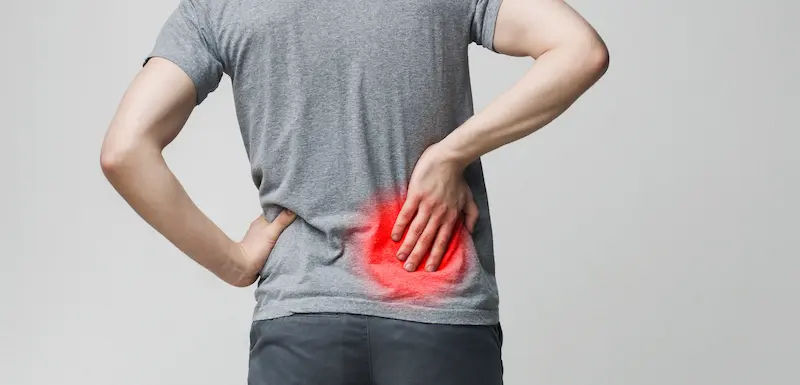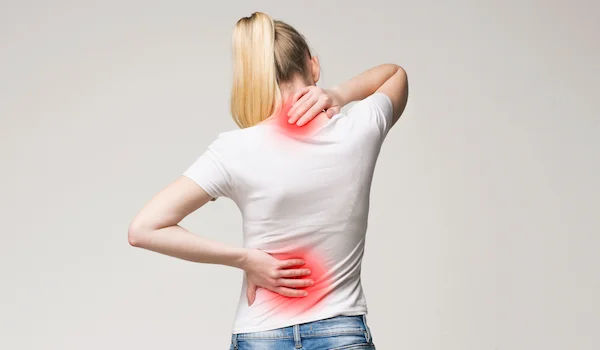Your Guide to Non-Surgical Relief for Arthritic Lower Back Pain
Find effective, non-surgical ways to manage lower back pain caused by spinal arthritis. This guide covers physical therapy, medications, lifestyle changes, and other treatments for lasting relief.

Written by Dr. Mohammed Kamran
Reviewed by Dr. Rohinipriyanka Pondugula MBBS
Last updated on 22nd Sep, 2025

Introduction
That persistent, nagging ache in your lower back that worsens with movement and improves with rest it could be more than just a strain. For millions, this pain is a daily reality caused by spinal arthritis, a degenerative condition that wears down the joints and discs in your spine. The thought of surgery can be daunting, but the good news is that a vast array of effective non-surgical pain management strategies exists. This comprehensive guide is designed to empower you with knowledge. We will delve into the causes of arthritic lower back pain, explore a wide spectrum of conservative treatment options—from simple at-home remedies to advanced medical procedures—and provide you with a roadmap to reclaim your comfort and mobility without going under the knife.
Understanding Spinal Arthritis: The Root of the Pain
It includes:
What is Spinal Arthritis?
Spinal arthritis isn't a single disease but an umbrella term for conditions that cause inflammation and deterioration of the joints in the spine. This inflammation leads to pain, stiffness, and a loss of flexibility. Unlike acute back pain from an injury, arthritic pain is often chronic, meaning it persists for more than three months. It's a progressive condition, but its progression can be significantly slowed, and its symptoms effectively managed, with the right approach.
Consult a Top General Practitioner for Personalised Advice
Common Types of Arthritis That Affect the Spine
The types of arthritis include:
Osteoarthritis (OA) of the Spine
This is the most common form of spinal arthritis, often referred to as "wear-and-tear" arthritis. It occurs when the protective cartilage that cushions the ends of the bones within your facet joints (the joints that connect your vertebrae) wears down over time. This leads to bone-on-bone friction, the formation of bone spurs (osteophytes), and can contribute to degenerative disc disease, all of which are major sources of lower back pain.
Ankylosing Spondylitis (AS)
This is a less common but more severe type of inflammatory arthritis that primarily affects the spine. It causes chronic inflammation that can eventually lead to the fusion of vertebrae, resulting in a rigid and inflexible spine. Pain and stiffness from AS are often worse in the morning or after periods of inactivity.
How Spinal Arthritis Leads to Chronic Pain
The pain mechanism is multifaceted:
1. Joint Inflammation: Inflamed facet joints are a direct source of localised pain.
2. Nerve Compression: Bone spurs or collapsed discs can encroach on the space meant for nerves, leading to radiating pain, numbness, or weakness (sciatica).
3. Muscle Strain: To compensate for a weakened spine, surrounding muscles can become tight and painful.
4. Stiffness: Loss of cartilage and fusion reduces mobility, making movement difficult and painful.
First-Line Non-Surgical Treatments: Taking Control at Home
Non-surgical and home based treatments inlcude:
Physical Therapy and Targeted Exercises
A cornerstone of non-surgical back pain treatment, physical therapy (PT) is designed to strengthen the muscles that support your spine, improve flexibility, and correct posture. A physical therapist will create a personalised program for you, which often includes:
- Core Strengthening: Targeting the abdominal and back muscles to create a natural "corset" for your spine.
- Low-Impact Aerobic Exercise: Such as walking or swimming, to improve blood flow and maintain mobility without jarring the joints.
- Stretching: To alleviate stiffness in the hips, hamstrings, and back.
Heat and Cold Therapy: When to Use Each
This simple, cost-effective method can provide significant relief.
- Cold Therapy (Ice Packs): Best for acute flare-ups of pain or new inflammation. Apply for 15-20 minutes to numb the area and reduce swelling.
- Heat Therapy (Heating Pads): Ideal for chronic stiffness and muscle tension. Use for 15-20 minutes to relax muscles and improve blood flow, making it easier to move and stretch. Many find that a warm shower first thing in the morning helps manage ankylosing spondylitis pain.
Mind-Body Techniques: Yoga and Tai Chi
These ancient practices are now validated by modern science for managing chronic pain. They combine gentle movement, stretching, and mindful breathing to:
- Improve flexibility and balance.
- Strengthen core muscles.
- Reduce stress, which is a known amplifier of pain perception.
- Look for classes specifically designed for lower back pain relief or for seniors, which focus on gentle, modified poses.
Medical Interventions for Pain Management
The over the counter medications include:
- Over-the-Counter (OTC) and Prescription Medications
- Medications can be a useful tool for managing flare-ups.
OTC Options
Nonsteroidal anti-inflammatory drugs (NSAIDs) like ibuprofen or naproxen are first-line choices as they tackle both pain and inflammation.
Prescription Options
For more severe pain, a doctor may prescribe stronger NSAIDs, muscle relaxants, or topical pain creams. In certain cases of nerve pain, medications like gabapentin may be used.
Injections for Targeted Relief: Epidurals and Facet Joint Injections
When oral medications aren't enough, injections can deliver powerful anti-inflammatory medicine directly to the source of pain.
- Epidural Steroid Injection: A corticosteroid is injected into the space around the spinal nerves. This is particularly effective for pain caused by nerve compression or inflammation (e.g., sciatica).
- Facet Joint Injection: The injection is delivered directly into the inflamed facet joint itself, providing targeted relief for arthritis-specific pain. This can also be used as a diagnostic tool to confirm the pain source.
Advanced and Alternative Non-Surgical Options
Radiofrequency Ablation (RFA): A Longer-Term Solution
RFA is a highly effective procedure for chronic facet joint pain. Using heat generated by radio waves, the procedure disables the specific nerves carrying pain signals from the arthritic joint to your brain. The result is pain relief that can last from 9 months to 2 years. While the nerves can regenerate, the procedure can be repeated.
Acupuncture and Chiropractic Care: The Evidence
- Acupuncture: This traditional Chinese medicine technique involves inserting fine needles into specific points. Evidence suggests it can help reduce chronic back pain by stimulating nerves, muscles, and connective tissue, promoting the body's natural painkillers.
- Chiropractic Care: Spinal manipulation can help improve mobility and alleviate pain in some individuals.
- Crucial Note: It is essential to see a licensed chiropractor who has experience working with arthritis patients, as certain manipulations may not be suitable for all types of spinal arthritis, especially advanced cases.
Lifestyle Modifications for Long-Term Management
The lifestyle modifications include:
Anti-Inflammatory Diet for Joint Health
What you eat can influence inflammation throughout your body. Adopting an anti-inflammatory diet can be a powerful adjunct to other treatments. Focus on:
- Omega-3 Fatty Acids: Found in fatty fish (salmon, mackerel), walnuts, and flaxseeds.
- Fruits and Vegetables: Rich in antioxidants (berries, leafy greens).
- Whole Grains and Healthy Fats.
- Limit: Processed foods, sugary drinks, and red meat, which can promote inflammation.
- Weight Management and Its Impact on Spinal Load
This is one of the most impactful changes you can make. Every extra kilogram of body weight adds multiple kilograms of pressure on your spine. Losing even a small amount of weight can significantly reduce the lower back pain caused by spinal arthritis by decreasing the constant load and stress on your facet joints and discs.
Conclusion
Living with arthritic lower back pain can be challenging, but it doesn't have to define your life. As we've explored, the arsenal of non-surgical pain management options is extensive and powerful. From the foundational practices of physical therapy and mindful movement to advanced procedures like RFA, you have numerous tools at your disposal. Success lies in a proactive, multi-disciplinary approach. If your condition does not improve after trying these methods, or if your pain is severe or accompanied by neurological symptoms like leg weakness, book a physical visit to a doctor with Apollo24|7 for a comprehensive evaluation.
Consult a Top General Practitioner for Personalised Advice
Consult a Top General Practitioner for Personalised Advice

Dr Syed Mateen Pasha
General Physician
2 Years • MBBS
Bengaluru
PRESTIGE SHANTHINIKETAN - SOCIETY CLINIC, Bengaluru

Dr. Anand Ravi
General Physician
2 Years • MBBS
Bengaluru
PRESTIGE SHANTHINIKETAN - SOCIETY CLINIC, Bengaluru

Dr. Johnson. S
General Practitioner
7 Years • MBBS MD(Preventive and social Medicine)
Pune
Apollo Clinic, Nigdi, Pune

Dr. Madhuri Sai Sreepada
General Practitioner
9 Years • MBBS
Hyderabad
BRIGHT SMILES MEDICARE & DENTAL CARE, Hyderabad
Dr. Karanam Kondalamma
General Practitioner
4 Years • MBBS
Hyderabad
KK Clinic, Hyderabad
Consult a Top General Practitioner for Personalised Advice

Dr Syed Mateen Pasha
General Physician
2 Years • MBBS
Bengaluru
PRESTIGE SHANTHINIKETAN - SOCIETY CLINIC, Bengaluru

Dr. Anand Ravi
General Physician
2 Years • MBBS
Bengaluru
PRESTIGE SHANTHINIKETAN - SOCIETY CLINIC, Bengaluru

Dr. Johnson. S
General Practitioner
7 Years • MBBS MD(Preventive and social Medicine)
Pune
Apollo Clinic, Nigdi, Pune

Dr. Madhuri Sai Sreepada
General Practitioner
9 Years • MBBS
Hyderabad
BRIGHT SMILES MEDICARE & DENTAL CARE, Hyderabad
Dr. Karanam Kondalamma
General Practitioner
4 Years • MBBS
Hyderabad
KK Clinic, Hyderabad
More articles from Back Pain
Frequently Asked Questions
What are the first signs of spinal arthritis?
Early signs often include persistent stiffness in the lower back, especially in the morning or after sitting, and a deep, aching pain that may improve with light activity but worsen with overuse.
Can spinal arthritis pain be cured?
While there is no cure for the degenerative process of osteoarthritis, the pain and symptoms can be very effectively managed through the non-surgical treatments outlined in this article, allowing you to maintain a high quality of life.
Is walking good for arthritic lower back pain?
Yes, in most cases, walking is an excellent low-impact aerobic exercise. It helps maintain flexibility, strengthens supporting muscles, and promotes blood flow to the spine, which can reduce stiffness and pain.
How long does a facet joint injection last for pain relief?
The pain relief from a facet joint injection can vary. Typically, the diagnostic effect lasts a few hours, while the therapeutic relief from the corticosteroid can last from a few weeks to several months.
What is the difference between degenerative disc disease and spinal arthritis?
They often occur together. Degenerative disc disease refers to the breakdown of the spinal discs (the cushions between vertebrae), while spinal arthritis (osteoarthritis) specifically refers to the wear-and-tear of the facet joints that connect the vertebrae. Both are sources of chronic lower back pain.


